In Korea, popular music started to thrive in the early 20th century, when overseas record labels produced commercial albums here and an increasing number of households enjoyed the luxury of a phonograph. Divided into the four genres of jazz, comic, new folk and popular songs, local pop music in the early days reflected the social ambience and public mentality of the era.
In 2018, the hottest issue in the local music scene was BTS, who have rewritten both Korean and world music history by breaking a series of industry records. Their most notable achievement was having two albums top the Billboard 200 chart in the same year, a first for Korean artists and for foreign-language albums.
It is simply amazing that in recent years BTS and other Korean pop artists have gained impressive popularity worldwide. About a century ago, when a native form of pop music was germinating among people living amid sorrow and self-deprecation under colonial oppression, who could have predicted such a thing?
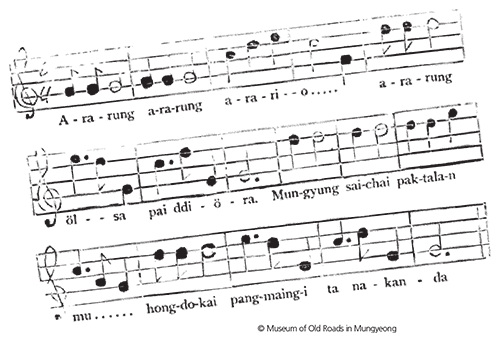
The score of the folk song “Arirang” published with the essay “Korean Vocal Music” by Homer B. Hulbert in the February 1896 issue of The Korean Repository, the first English-language magazine in Korea.
Commercial Albums
Popular music, and indeed the concept of a mass audience, emerged at the start of modern times in Korea. That is not to say there were no songs that enjoyed wide popularity in pre-modern Korea. For instance, Homer B. Hulbert, the American missionary and educator whose love for Korea is well-known, introduced the lyrics and score of the folk song “Arirang” in an essay titled “Korean Vocal Music,” carried in the February 1896 issue of The Korean Repository, the country’s first English-language magazine. In his article, Hulbert wrote, “For the average Korean, this one song holds the same place in music that rice does in food.” Although the “Old Arirang” mentioned in this article is one of numerous variations of the folk song and different from the better-known “Bonjo Arirang” (“Standard Arirang”), it is clear how popular the song was at the time.
So, while there were songs that enjoyed widespread popularity even before the advent of popular music in today’s sense, the fact that modern pop music was disseminated through the mass media and the record industry clearly distinguishes it from the music that came before. Since the pursuit of profit is the ultimate purpose of producing commercial records, pop music is a commercial product as well as a form of art. For this reason, “Arirang” is not classified as pop music in Hulbert’s article.
Korea’s music industry was launched in 1907 when the American music label Columbia Records released the country’s first commercial record. It was an album by Han In-o, a renowned singer of traditional songs from the Gyeonggi region, and Choe Hong-mae, a gisaeng, or traditional-style female entertainer. Soon after, Victor Records also entered the market and records by famous artists and singers of the time were quickly released one after another. Naturally, phonographs played a critical role in the spread of popular music. Before radio broadcasting began in Korea in the late 1920s, phonographs had made their way into the daily lives of the upper class, contributing to the development and popularization of music.
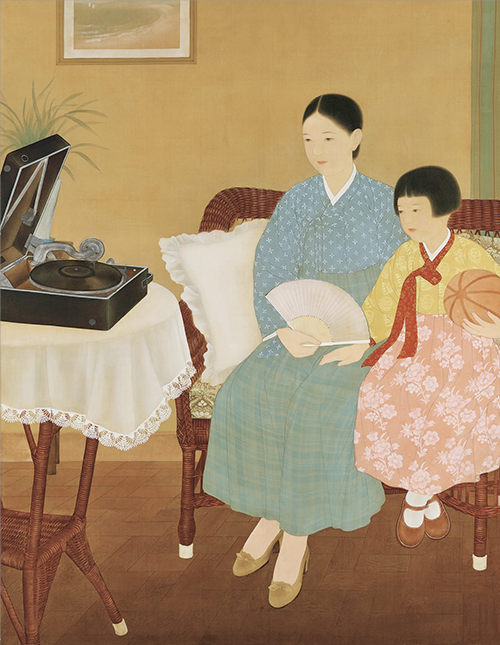
“Quiet Listening” (1934)Kim Ki-changInk and color on silk 159 × 134.5 cm Depicting a modernized family of the 1930s, the painting was allegedly set in the well-decorated drawing room of a doctor who lived in the same neighborhood as the artist.
Jazz Boom
As is true of most new cultural phenomena, modern Korean pop music resulted from the encounter of native and foreign culture and their competition and coexistence. It was largely a byproduct of three major influences: traditional Korean music, Western music and Japanese music. Although identifying the interaction between these elements is not easy, the prevalence of one of these influences helped shape a genre in this early phase.
In this era, four genres of pop music developed: so-called jazz songs, comic songs (manyo), new folk songs (sinminyo) and popular songs (yuhaengga). The distinctions were not clear to start with, but for some time from the 1930s, when a true pop music market began to form, every song was labeled as one of those genres.
Jazz songs of that time differed from today’s concept of jazz. It was a term encompassing almost all Western pop music, including Latin pop, as well as regular jazz. Koreans were first exposed to Western music and instruments through Christian hymns and Western band music. In the mid-1920s, Western music had an ever- increasing influence, giving rise to a jazz boom.
In 1926, Baek Myeong-gon, the son of a weal- thy family in the Jeolla region, led a Korean football team to play an away game in Shanghai. He came home with jazz instruments and scores and formed the Korean Jazz Band.
In the 1920s, jazz songs with lyrics advocating the pursuit of pleasure were hugely popular among the young urbanites of Gyeongseong (today’s Seoul), who were called the “modern girls” and “modern boys.” The jazz boom, largely influenced by films and records, was not received all that favorably, though. One intellectual derided the phenomenon, saying, “The modern girls and boys are just swinging their buttocks, lost in a frivolous fantasy.” However, among the musicians affiliated with record companies, quite a few were seriously committed to learning authentic jazz music by emulating Western jazz musicians.
The jazz boom of the late 1920s paved the way for a rush of jazz songs in the 1930s. At first, they were mostly adaptations of Western or Japanese songs, one such case being “Dinah” (originally by Bing Crosby). Original songs, such as “Young Dreams in the Coffee House” (Dabang-ui pureun kkum) were created later, from the mid-1930s and onwards.
Life went on and culture flourished even in the depths of despair,
giving rise to songs that laid the foundation for today’s musical affluence.
Sympathy vs. Sarcasm
Manyo, or comic songs, was a genre classified not by musical style but by the humorous nature of the lyrics. The term comes from mandam, a form of standup comedy generally performed by a duo. Similarly, manyo had witty lyrics that induced two different types of laughter - humorous and satirical. The former contained empathy, and the latter criticism; the former was warm and the latter cold.
“Sightseeing in Seoul” (Seoul gugyeong) was wildly popular from the 1950s until the 1970s. A remake of the “The Jolly Old Countryman” (Yu-kwaehan sigol yeonggam) sung by Kang Hong-sik in 1936, it is the farcical portrayal of an old countryman who takes the train to Seoul for the first time and runs into a string of troubles. People would have a good laugh while listening to the song, feeling compassion for the old man who makes so many mistakes. Perhaps he reminded them of themselves, adrift in the sea of modernity. On the contrary, “The Sham College Boy” (Gajja daehaksaeng) mocks the young man next door who skips school and spends all day playing billiards or chasing girls. The sarcasm is aimed not only at the man in the song but all the spoiled college students of the time. The satire in the song both amused and awakened the listeners to social problems. Given that satire thrives when political oppression and censorship prevail, the song reflects the hard reality of Koreans in those days when they were oppressed and exploited by the Japanese colonizers.
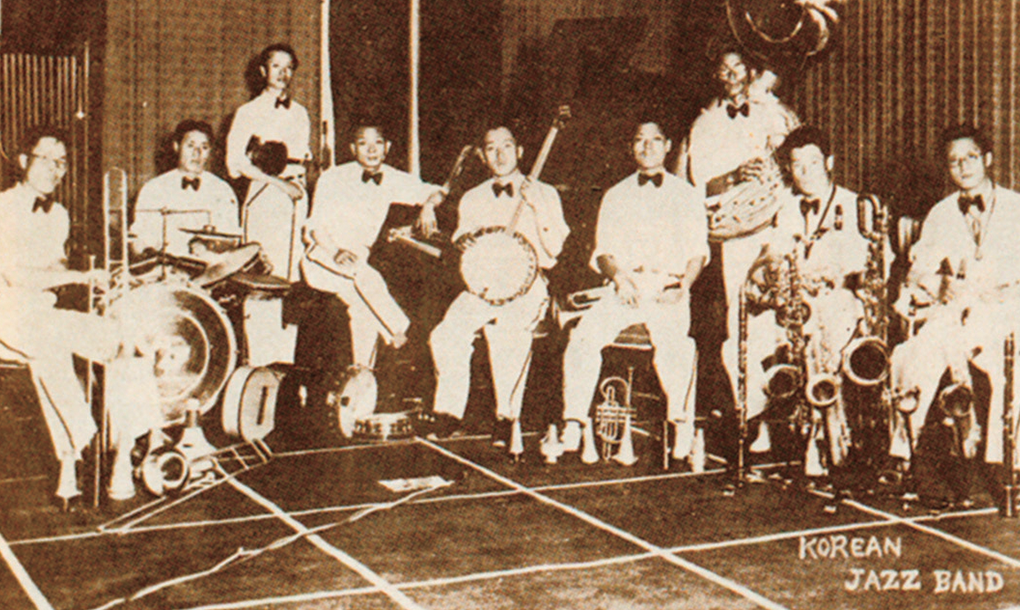
The Korean Jazz Band photographed after their first performance at Gyeongseong Broadcasting Station (JODK) in the summer of 1929.
Sinminyo, or new folk songs, were a form of indigenous pop music in which traditional elements were preserved through the adoption of certain aspects of native Korean music and folk songs. Borrowing refrains from traditional songs, using the accompaniment of native instruments, or employing old singing styles, the songs embraced local musical traditions in various ways. An early example is the title track for the 1926 film “Arirang,” directed by Na Woon-gyu, which was extremely popular.
In the mid-1930s, a large number of gisaeng debuted as singers. These female entertainers who had been formally trained to sing and dance at vocational schools and agencies were “ready-made” performers. Proficient in traditional vocal styles, they distinguished themselves in singing the new folk songs. The audiences of the time were especially fond of these songs that appealed more readily to their inherent sensibilities. This probably explains why Wang Su-bok, a gisaeng who sang in a 1933 album, won the first place among all the recorded singers in a popularity contest held in 1935 by Samcheolli Co., which published the culture magazine “Samcheolli” (a name that refers to the whole land of Korea).
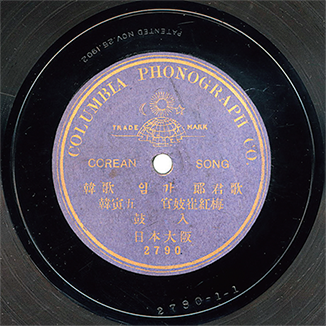
Released by Columbia Records in 1907, “Corean Song” is a single-sided record containing traditional folk songs of Gyeonggi Province sung by Han In-o. © Korea Record Archive at Dongguk University
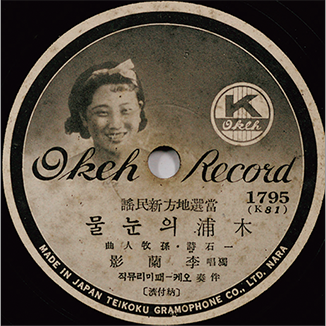
“Tears in Mokpo” by Yi Nan-yeong, released in 1935 by Okeh Record Co., consoled Koreans living in a colonized land. The song still remains popular today.
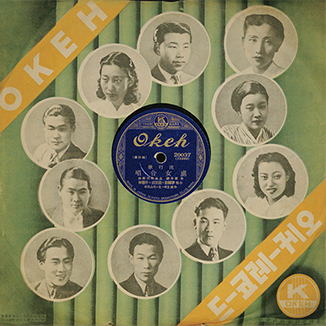
“The First Ensemble,” released in 1940, is a compilation of singers under exclusive contract with Okeh Record Co. The first record company established by a Korean, Okeh Record Co. was launched in 1932. © Korea Creative Content Agency
Solace in Troubled Times
Also appearing in this period were the so-called “trot” songs, the name originating from the English term “fox trot,” a style of ballroom dance which supposedly influenced the rhythm. Called yuhaengga, meaning “popular songs,” they were influenced by Japanese pop music, and thus had the same formal characteristics of the two-beat rhythm, minor keys and pentatonic scale. The Japanese music that influenced these songs, however, was not actually of Japanese origin. Earlier on, Japan had been proactive in adopting Western culture and the encounter of Western and Japanese music produced enka, or ballads. At first, this genre was also called ryukoka, meaning “popular songs,” in Japanese, but it was renamed enka and treated as traditional pop music in the 1960s. In the sense that they were exalted to the status of traditional music as part of the country’s endeavor to redefine national identity, Japanese enka could be called an invented tradition.
Although long stigmatized as a product of Japanese culture, trot has been generally enjoyed in Korea and is very much alive even today. Created in the colonial period, trot has continued to be loved over the years because it relates to the lives and emotions of people in troubled times. It is presumed that the name trot began to be used as the title of the pop music genre in the 1950s. The most popular songs from the heyday of trot include “Living Far Away from Home” (Tahyang sari) about the sorrow of living as a stranger in a faraway place, and “Tears in Mokpo” (Mokpo-ui nunmul) expressing passive resistance against Japanese occupation. These songs spoke for dejected and sorrowful lives, offering great solace to the public.
Modernity in Korea was another name for despair, since it was not achieved voluntarily and autonomously. However, life went on and culture flourished even in the depths of despair, giving rise to songs that laid the foundation for today’s musical affluence. In this sense, Korean pop music is like a flower that bloomed in the darkness of modernity, offering comfort to troubled souls.